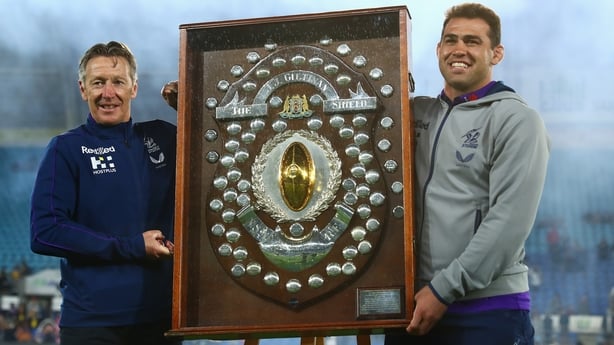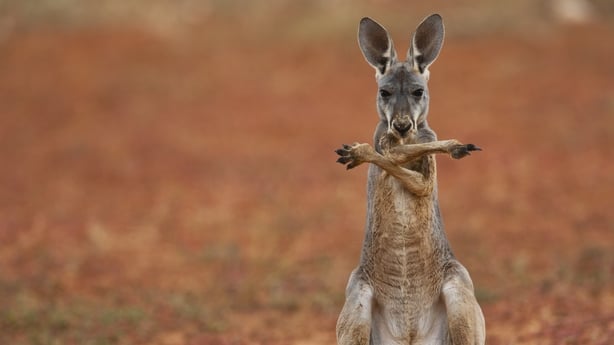This weekend sees the Rugby League World Cup kick off in England, with Ireland among the 16 teams taking part.
Northern England is the spiritual home of rugby league, but in 1908 the sport gathered momentum around Sydney.
Like northern England, the game was strongest within the working class community and, among those playing key roles in the new sport, were people with Irish heritage.
Thanks to these people and others, rugby league has progressed to the point where the Kangaroos have won 11 out of 15 World Cups and are the favourites to win the World Cup again.
So while rugby league has never really prospered in Ireland itself, the Irish made a remarkable impact on rugby league in Australia in its early days.
Among the early promoters of the new game was James Joseph Giltinan. His grandfather Kingsmill Giltinan had left Cork for Sydney in 1837. Kingsmill, who was a cooper, left of his own volition at a time when most Irish arriving in New South Wales were convicts.
His grandson JJ was one of the key organisers in bringing a professional team from New Zealand in 1907 to play in New South Wales. Rugby was amateur at this time and the players on the All Golds, as they were nicknamed, were banned from rugby union for life.
The tour played three games in Sydney under rugby union rules but it was a resounding success which encouraged those in Sydney to set up a meeting that saw the formation of a new league and clubs in NSW.
Giltinan was elected the first secretary of the New South Wales Football League and was heavily involved in advancing the sport.
After his death in 1950, the New South Wales Rugby Football League introduced the JJ Giltinan Shield for the team that tops the league standings at the end of the season before the playoffs.

One of the earliest clubs to get involved were South Sydney Rabbitohs. The main man at the club was Arthur Hennessy, whose Tipperary-born grandfather Patrick arrived Down Under as a convict. Arthur had played rugby union at club level and for New South Wales. He became a central figure in the breakaway from rugby union.
Hennessy is considered the founding father of the South Sydney rugby league club as it was essentially formed in his house.
The split caused much hurt and divided friends but Hennessy was resolute in his belief that league was the superior game.
As the Rabbitohs website describes him in their Hall of Fame section, he was a pioneer in so many ways – a pioneer rugby league player, a pioneer of a unique style of play, and a pioneer of the South Sydney football club.
A hooker and prop forward, Hennessy was Souths' first captain and coach. He was also New South Wales' first captain and Australia's first test captain in 1908. Hennessy was the number one man; he is listed as the first player for the Rabbitohs and first player for the Australia rugby league team.
The Rabbitohs are now the most successful team in Australia with 21 championships. The Bunnies are the oldest professional team still operating in the NRL. The heart of the club is Redfern, a once strong working class area and it is here that the team is based, although often they play matches in larger stadiums due to their popularity.
Hennessy was a member of the first Australian rugby league tour to Britain in 1908. Joining him on the tour was Larry O'Malley. He was just one when his family moved to Sydney from Ireland as assisted immigrants in 1884. O’Malley had grown up playing union but was an early convert to league, joining the Eastern Suburbs club.
He played in the first league interstate match in 1908 for New South Wales against Queensland.
Today, the State of Origin games played between New South Wales and Queensland are massive events in Australia.
The fiery redhead was a no-nonsense forward and on the tour he played 34 of the gruelling 45-game schedule.
The Australia team had numerous Irish surnames on it. O’Malley’s Eastern Suburbs team-mate Dan Frawley, of Irish parentage, was the speedster of the team and was among the leading tryscorers.
He was a colourful character, who stayed on to play for Warrington and was part of the second Kangaroo tour in 1912.
Pat Walsh was an experienced union international for that time but having been dropped from union and having tried his hand at Aussie Rules, he then took to league with aplomb. He scored nine tries in 29 matches on the tour.

Walsh also brought a live kangaroo with him for the tour, but the poor animal died due to the adverse weather conditions.
Walsh would stay on for two years and played league for Huddersfield.
Jimmy Devereux, whose parents were Irish, was part of the first New South Wales team who played against New Zealand.
Listed as Kangaroo number four, he was the top tryscorer on the tour. He would end up playing for Hull for much of his career.
Albert Conlon was a member of the Glebe club and played in minor games due to an injury.
That Kangaroos tour was a financial failure, with tour promoter Giltinan going bankrupt. However, in playing terms it helped establish the rivalry between Britain and Australia.
Acting as tour assistant manager was John Fihelly. Like O’Malley, he moved to Australia at the age of one with his family as an immigrant when his family from Timoleague, west Cork moved to Brisbane.
Fihelly would progress to earn one cap for the Australian rugby union team in 1907 but the following year he was a founding father of league in Queensland.
Among the others involved in setting it up were Irish-Australians Sine Boland and John O’Connor.
Fihelly would earn state and national caps in the new code. He also went into state politics. He was a member of the Queensland Assembly for 10 years as a Labor Party representative and was treasurer of Queensland between 1920 and 1922.
While Irish names aren’t as prevalent on the Kangaroos teamsheet these days, the Irish impact on Australian rugby league has had an interesting knock-on effect for the Irish rugby league team.
The team is backboned by players of Irish heritage, mostly from England but some who have been born and raised in Australia and who qualify to play through a parent or a grandparent.
The Wolfhounds, ranked 12th in the world, will fancy their chances of making the knockout stages where there could potentially be an interesting match-up with Australia in the quarter-finals. Here’s hoping.
Samuel Kingston is a historian from Clonakilty who is currently researching a book on the Irish impact on sports around the world.

